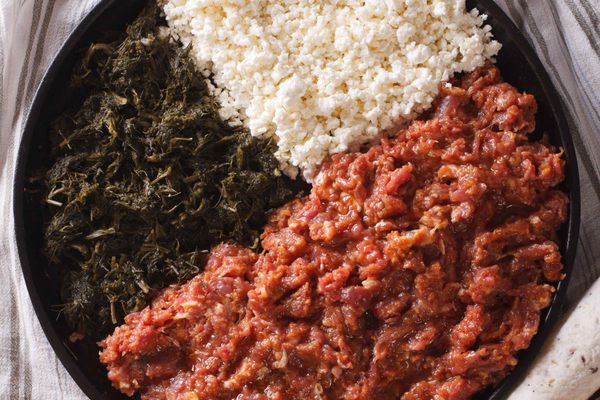Fruits & Vegetables
Enset
Some bread goes in the oven for an hour; some goes underground for two years.
It looks like a banana plant, harvests like a root vegetable, and tastes like flatbread. Though the enset is a technical cousin of the banana, this tree offers a food that is much more potato-like. English-speakers—feeling betrayed by the enset’s misleading appearance—decided to call it “the false banana.” Its vaguely banana-like pods are short, thick, and filled with seeds, but it’s not the fruit that makes enset worth planting.
Unlike plucking bananas, harvesting from the enset requires prying the entire plant from the ground. Its pseudo-stem contains a starchy pith that can be pulped and fermented into a calorie-dense carbohydrate. This can be acquired throughout the year, which provides a buffer against famine when seasonal crops fail.
Once the pith is collected using a bamboo scraper, it gets pulped, combined with yeast, and bundled. The mixture is placed into an enset leaf–lined pit, covered by leaves and rocks, and then left to ferment for up to two years. After a minimum of three months of subterranean fermenting, enset can be used to make a dense, bread-like staple called kocho. Kocho is thought to taste better with age, going from green to white and acquiring a cheese smell as it ripens.
To make kocho from fermented enset, a portion is chopped and mixed with spices and butter, then formed into flat discs and baked in clay pans, on a griddle, or in an oven pit. Served with milk, cheese, cabbage, meat, or coffee, this versatile carbohydrate adds bulk to meals. Kocho is sticky unless toasted, in which case it takes on a crispy, cracker-like quality. It’s used as a utensil and, because the left hand is considered unclean in Ethiopian culture, eaten using only the right hand.
Enset’s ubiquity and utility make it a commodity. Fermented kocho may be used for bread, sale, or trade—enset pits are overseen by the women of the household and regarded as assets. The by-product of the pseudo-stem pulping process also has value. This collection of tough fibers gets turned into ropes, mats, and sacks.
Domesticated enset is almost unknown outside of Ethiopia, but it provides a staple crop for roughly 15 million people just within the country’s southwestern region. Historically, enset developed a polarizing connotation as “peasant fare,” and urban-dwelling Ethiopians have been apprehensive about a staple that was once reserved for the impoverished. But while it may not be trendy, enset is remarkable, allowing people to make bread, rope, plates, and even furniture.
The enset might not provide bananas, but it provides just about everything else.
Written By
 rachelrummel
rachelrummel















